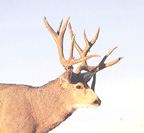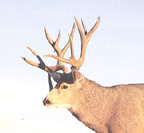Description Mule Deer have large ears that move constantly and independently,
hence they get their name, "Mule" or "Burro Deer."
They do not run as other deer, but have a peculiar and distinctive bounding
leap ,can leap distances up to 8 yards, with all 4 feet coming down together.
In this fashion, they can reach a speed of 45 m.p.h. for short periods.
This stocky deer with sturdy legs is 4 to 6-1/2 feet in length and 3 to 3-1/2
feet high at the shoulder.
During the summer, the coat on its upper body is yellow- or reddish-brown,
while in winter more gray. The throat patch, rump patch, inside ears and inside
legs are white with lower portions running cream to tan. A dark V-shaped mark,
extending from a point between the eyes upward and laterally is characteristic
of all Mule Deer but is more conspicuous in males.
Males are larger than females. The bucks' antlers, which start growth in spring
and are shed around December each year, are high and branch forward, forking
equally into 2 tines with a spread up to 4 feet.
The Mule Deer is slower and less colorful than the White-tailed Deer, but
its pastel, gray-buff color provides a physical adaptation to the desert environment
which disguises it from predators like the Cougar, the Coyote and the eagle
who will swoop down on a fawn.
Mule Deer have no canine teeth and, like the cow, have a multi-part stomach,
the first two chambers of which act as temporary storage bins. Food stored
here can be digested later when the deer chews its cud.
Behavior Seasonal movements involving migrations from higher elevations (summer
ranges) to lower winter ranges are associated, in part, with decreasing temperatures,
severe snowstorms, and snow depths that reduce mobility and food supply. Deep
snows ultimately limit useable range to a fraction of the total.
Mule Deer in the arid southwest may migrate in response to rainfall patterns.
When startled, a Mule Deer will move in a series of stiff-legged jumps with
all four feet hitting the ground together. This gait offers two advantages:
it allows the deer to outdistance predators in rough terrain, and to see above
the thick brush. If necessary, they can turn or completely reverse direction
in the course of a single bound.
Mule Deer are active primarily in mornings, evenings and moonlit nights. This
inactivity during the heat of the day is a behavioral adaptation to the desert
environment that conserves water and keeps the body temperature within livable
limits. Sweat glands and panting also provide evaporative cooling during hot
periods. During the middle of the day, the Mule Deer beds down in a cool,
secluded place.
The mature buck seems to prefer rocky ridges for bedding grounds, while the
doe and fawn is more likely to bed down in the open.
Habitat Mule Deer moves between various zones from the forest edges at higher
elevations to the desert floor, depending on the season.
While the Mule Deer occupies almost all types of habitat within its range,
it seems to prefer arid, open areas and rocky hillsides.
Food & Hunting Food of the Mule Deer is quite varied. In Spring and Summer
it feeds on green leaves, herbs, weeds and grasses more than on browse species.
The reverse is true in Fall and Winter. Mule Deer are browsers and eat a great
variety of vegetable matter, including fresh green leaves, twigs, lower branches
of trees, and various grasses. They are particularly fond of blackberry and
raspberry vines, grapes, mistletoe, mushrooms and ferns. They eat so carefully
they can even consume the fruit of cactus.
![]() HOME
HOME
![]() Deerslayer Pics 1
Deerslayer Pics 1 ![]() Deerslayer Pics 2
Deerslayer Pics 2 ![]() Deerslayer Pics 3
Deerslayer Pics 3 ![]() Deerslayer Pics 4
Deerslayer Pics 4 ![]() Deerslayer Pics 5
Deerslayer Pics 5
![]() Deerslayer Pics 6
Deerslayer Pics 6
![]() Deerslayer Pics 7
Deerslayer Pics 7
![]() Deerslayer Pics 8
Deerslayer Pics 8![]() More Pics & Products ----
More Pics & Products ----
![]() Links page --
Links page -- ![]() My Hunting Tips on Care and Recipes
My Hunting Tips on Care and Recipes 
